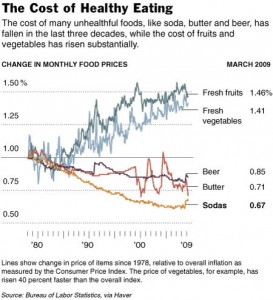Strong opinions about obesity
Investigators at the Harvard School of Public Health estimated the toll of behavioral contributors to early mortality. Obesity, they say, is the #3 cause of death after cigarette smoking and high blood pressure.
Dutch researchers say smoking is what kills people. Obesity just leads to disability.
The Robert Wood Johnson Foundation says schools could do something to help prevent obesity if they got their act together. It provides a guide to doing so.
Adam Drewnowski, my colleague and friend at the University of Washington, says: if you want to understand obesity, take a look at what poverty makes people eat.
And Jeffrey Friedman, an obesity researcher at Rockfeller University tells Nature that obesity is neither an epidemic nor a disease of lifestyle. It’s all in the genes and in evolution.
I say (see What to Eat): eat less, move more, eat plenty of fruits and vegetables, and don’t eat too much junk food!



